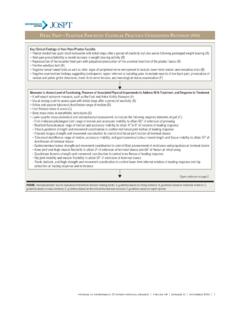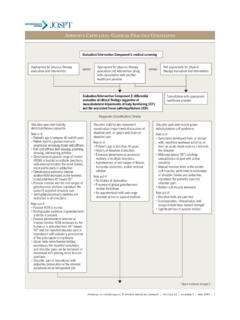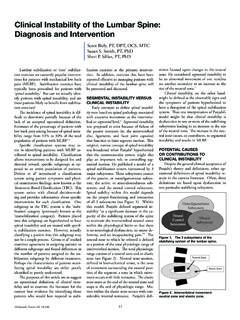Transcription of Neck Pain: Clinical Practice Guidelines Revision 2017
1 Neck Pain: Clinical Practice Guidelines Revision 2017 Neck Pain With Mobility DeficitsCommon symptoms Central and/or unilateral neck pain Limitation in neck motion that consistently reproduces symptoms Associated (referred) shoulder girdle or upper extremity pain may be presentExpected exam findings Limited cervical ROM Neck pain reproduced at end ranges of active and passive motions Restricted cervical and thoracic segmental mobility Intersegmental mobility testing reveals characteristic restriction Neck and referred pain reproduced with provocation of the involved cervical or upper thoracic segments or cervical musculature Deficits in cervicoscapulotho-racic strength and motor control may be present in individuals with subacute or chronic neck painNeck Pain With Movement Coordination Impairments (WAD)
2 Common symptoms Mechanism of onset linked to trauma or whiplash Associated (referred) shoulder girdle or upper extremity pain Associated varied nonspecific concussive signs and symptoms Dizziness/nausea Headache, concentration, or memory di culties; confusion; hypersensitivity to mechanical, thermal, acoustic, odor, or light stimuli; heightened a ective distressExpected exam findings Positive cranial cervical flexion test Positive neck flexor muscle endurance test Positive pressure algometry Strength and endurance deficits of the neck muscles Neck pain with mid-range motion that worsens with end-range positions Point tenderness may include myofascial trigger points Sensorimotor impairment may include altered muscle activation patterns, propriocep-tive deficit, postural balance or control Neck and referred pain reproduced by provocation of the involved cervical segmentsNeck Pain With Headache (Cervicogenic)
3 *Common symptoms* Noncontinuous, unilateral neck pain and associated (referred) headache Headache is precipitated or aggravated by neck movements or sustained positions/posturesExpected exam findings Positive cervical flexion-rotation test Headache reproduced with provocation of the involved upper cervical segments Limited cervical ROM Restricted upper cervical segmental mobility Strength, endurance, and coordination deficits of the neck musclesNeck Pain With Radiating Pain (Radicular)Common symptoms Neck pain with radiating (narrow band of lancinating) pain in the involved extremity Upper extremity dermatomal paresthesia or numbness, and myotomal muscle weaknessExpected exam findings Neck and neck-related radiating pain reproduced or relieved with radiculopathy testing: positive test cluster includes upper-limb nerve mobility, Spurling s test, cervical distraction, cervical ROM May have upper extremity sensory, strength, or reflex deficits associated with the involved nerve rootsEvaluation/Intervention Component 1: medical screeningAppropriate for physical therapy evaluation and interventionEvaluation/Intervention Component 2.
4 Classify condition through evaluation of Clinical findings suggestive of musculoskeletal impairments of body functioning (ICF) and the associated tissue pathology/disease (ICD)Appropriate for physical therapy evaluation and intervention along with consultation with another health care providerNot appropriate for physical therapy evaluation and interventionConsultation with appropriate health care providerversusversusFIGURE. Proposed model for examination, diagnosis, and treatment planning for patients with neck pain. *Clinicians are encouraged to refer to the International Classification of Headache Disorders83 for a more inclusive list of headache types/classifications ( ), and to The National Institute for Health and Care Excellence149 for signs, symptoms, and conditions that should be considered in patients who present with a headache in addition to neck continues on page of orthopaedic & sports physical therapy | volume 47 | number 7 | july 2017 | 147-07 Neck Pain 228/25/2017 1:14:16 PMNeck Pain.
5 Clinical Practice Guidelines Revision 2017journal of orthopaedic & sports physical therapy | volume 47 | number 7 | july 2017 | 2 Neck Pain With Mobility DeficitsAcute Thoracic manipulation Cervical mobilization or manipulation Cervical ROM, stretching, and isometric strengthening exercise Advice to stay active plus home cervical ROM and isometric exercise Supervised exercise, including cervicoscapulothoracic and upper extremity stretching, strengthening, and endurance training General fitness training (stay active)Subacute Cervical mobilization or manipulation Thoracic manipulation Cervicoscapulothoracic endurance exerciseChronic Thoracic manipulation Cervical mobilization Combined cervicoscapulotho-racic exercise plus mobilization or manipulation Mixed exercise for cervicoscapu-lothoracic regions neuromus-cular exercise: coordination, proprioception, and postural training; stretching; strengthen-ing; endurance training; aerobic conditioning.
6 And cognitive a ective elements Supervised individualized exercises Stay active lifestyle approaches Dry needling, low-level laser, pulsed or high-power ultrasound, intermittent mechanical traction, repetitive brain stimulation, TENS, electrical muscle stimulationNeck Pain With Movement Coordination Impairments (WAD)Acute if prognosis is for a quick and early recovery Education: advice to remain active, act as usual Home exercise: pain-free cervical ROM and postural element Monitor for acceptable progress Minimize collar useSubacute if prognosis is for a prolonged recovery trajectory Education: activation and counseling Combined exercise: active cervical ROM and isometric low-load strengthening plus manual therapy (cervical mobilization or manipulation) plus physical agents: ice, heat, TENS Supervised exercise: active cervical ROM or stretching, strengthening, endurance, neuromuscular exercise including postural, coordination, and stabilization elementsChronic Education: prognosis, encouragement, reassurance, pain management Cervical mobilization plus individualized progressive exercise.
7 Low-load cervicoscapu-lothoracic strengthening, endurance, flexibility, functional training using cognitive behavioral therapy principles, vestibular rehabilitation, eye-head-neck coordination, and neuromuscular coordination elements TENSNeck Pain With Headache (Cervicogenic)Acute Exercise: C1-2 self-SNAGS ubacute Cervical manipulation and mobilization Exercise: C1-2 self-SNAGC hronic Cervical manipulation Cervical and thoracic manipulation Exercise for cervical and scapulothoracic region: strengthening and endurance exercise with neuromuscular training, including motor control and biofeedback elements Combined manual therapy (mobilization or manipulation) plus exercise (stretching, strengthening, and endurance training elements)Neck Pain With Radiating Pain (Radicular)Acute Exercise: mobilizing and stabilizing elements Low-level laser Possible short-term collar useChronic Combined exercise: stretching and strengthening elements plus manual therapy for cervical and thoracic region.
8 Mobilization or manipulation Education counseling to encourage participation in occupational and exercise activity Intermittent tractionEvaluation/Intervention Component 3: determination of condition stage (acute/subacute/chronic)Evaluation/Inter vention Component 4: intervention strategies for patients with neck painAcute, subacute, and chronic stages are time-based stages helpful in classifying patient conditions. Time-based stages are helpful in making treatment decisions only in the sense that in the acute phase, the condition is usually highly irritable (pain experienced at rest or with initial to mid-range spinal movements: before tissue resistance); in the subacute phase, the condition often exhibits moderate irritability (pain experienced with mid-range motions that worsen with end-range spinal movements: with tissue resistance); and chronic conditions often have a low degree of irritability (pain that worsens with sustained end-range spinal movements or positions: overpressure into tissue resistance).
9 There are cases where the alignment of irritability and the duration of symptoms does not match accordingly, requiring clinicians to make judgments when applying time-based research results on a patient-by-patient basisFIGURE. Proposed model for examination, diagnosis, and treatment planning for patients with neck pain. *Clinicians are encouraged to refer to the International Classification of Headache Disorders83 for a more inclusive list of headache types/classifications ( ), and to The National Institute for Health and Care Excellence149 for signs, symptoms, and conditions that should be considered in patients who present with a headache in addition to neck Neck Pain 238/25/2017 1:14:16 PMNeck Pain: Clinical Practice Guidelines Revision 2017tion to neck pain.
10 Overall, classification is critical for match-ing the intervention strategy that is most likely to provide the optimal outcome for a patient s condition. However, it is important for clinicians to understand that patients with neck pain often exhibit signs and symptoms that fit more than 1 classification, and that the most relevant impairments of body function and the associated intervention strategies often change during the patient s episode of care. Thus, con-tinual re-evaluation of the patient s response to treatment and the patient s emerging Clinical findings is important for providing the optimal interventions throughout the patient s episode of 3111 For research purposes, acute, subacute, and chronic stages are time-based stages helpful in classifying patient condi-tions and in making treatment decisions.






